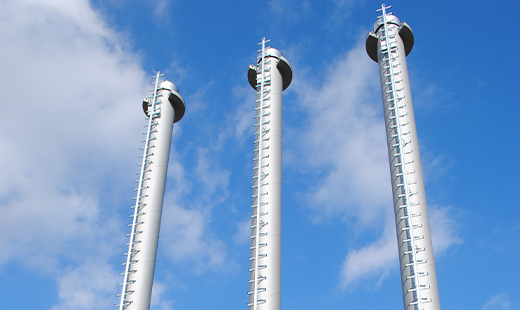Accessories for industrial chimneys
Useful additions and individually selectable additional components



Work and measurement platform
The work and measurement platform is manufactured in square and round, circumferential 135°/ 180°/270°/ 360° constructions. Each design has a handrail, knee rail and foot rail. The standing area is made of grating to ensure drainage of rain water and also prevent ice formation. All components are hot-dip galvanised or made of stainless steel and can be coated in chimney colours or special colors on request.



Ladder
The ladder is added for existing compulsory sweeping of the exhaust system through the opening, in accordance with UVV on the supporting pipe (usually on the outside). There is the option here to use a single-arm ladder in the middle of which a guiderail is incorporated and the person climbing is equipped with a runner and safety belt. This ladder is provided with a fold-out rest platform every 32 ft and there is also a „concluding platform) 47 inch below the opening. In addition to the single-arm ladder, there is an option to climb using a double-arm ladder with safety cage. In this variation, the integrated safety cage excludes the need for runners and belts. Instead of a fold-out platform, a transfer platform is needed every 19 - 32 ft to ensure safe climbing



Chimney top
The chimney top, usually made of stainless steel (material the same as internal pipe) is used to cover the insulation and the rear ventilation between the internal and external pipes. With the sole mount on the internal pipe, the hood ensures unrestricted expansion of the inner duct. The height of the hood is determined based on the exhaust temperature and the height of the chimney, as both of these factors are significant for the expansion.



Wall mount
A steel structure is fixed to the building at a defined point according to static calculations to absorb the horizontal forces. These can be positioned on walls, steel beams and ceilings. However, the basis of such a type of fastening is the absorption of static or dynamic loads at the connection point. When using a wall connection, almost all horizontal loads are transferred to the connection point. This eliminates the need to install an anchor cage, meaning that the foundation only has to absorb the weight and is therefore as small as possible.



Lightning protecion
The lightning protection hanger that is added to the base point of the chimney is used to deflect lightning strikes to a lightning deflector installed on the building. The lightning protection connection must ensure earthing
of the chimney system. The connection is done on site by an appropriate lightning protection company.

Swivel arm
A load boom with manual/motorized winch is used for easy transport of heavy measuring equipment or accessories, which decisively reduces the risk of accidents when climbing to the measuring/inspection point.



Flight obstacle lighting
Obstacle lighting is used to mark the chimney mouth and is specifically required in flight paths at public and private airports. This can also be required for landing sites at hospitals. The power supply to the halogen or LED lamps (4000 or 10000 operating hours) at the mouth is carried out through cable ducts inside or on the outside of the chimney support pipe.
In addition to lighting, warning painting in the form of signal stripes or other markings is possible, which makes it easier to recognize in daylight.



Special surface painting
Special paintwork to mark the day, as an identifying feature, e.g. by placing a company logo or simply to better fit the chimney into the surrounding area are also possible. These are applied using stencils in several painting steps and can therefore be easily painted in multiple colors. So there are no limits to your creativity!




Bottom flange / foundation basket
The statically arranged bottom flange, welded onto the external pipe, serves as the fitting on the foundation basket set in concrete. It is positioned on the setting nuts and mounted with two rows of nuts (fixing nuts and
counter nuts). To ensure stability, the bottom flange is usually reinforces with „rubbed steel“ and with an upper reinforced ring. The setting area between the bottom flange and foundation (approx. 2 inch) must be force-fit grouted with non-shrinking mortar after the assembly.
